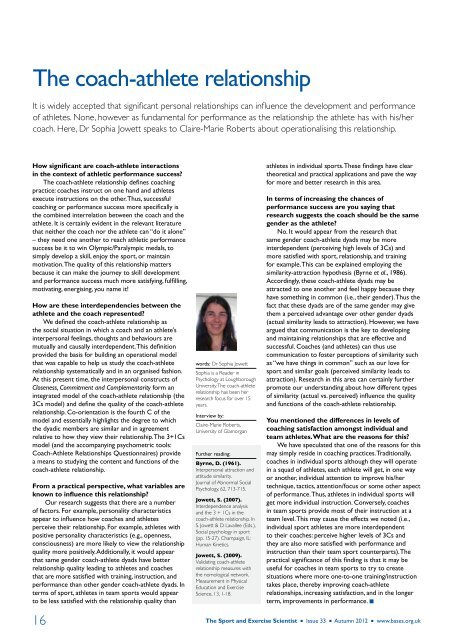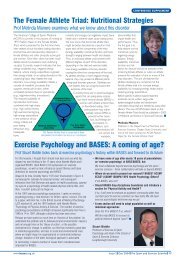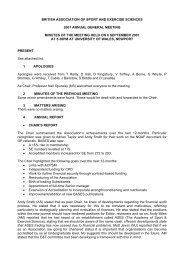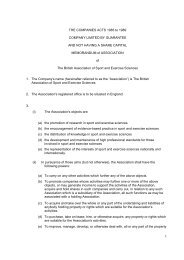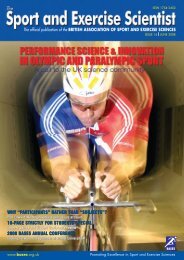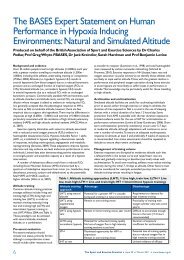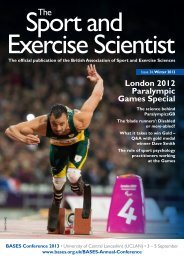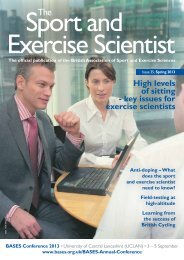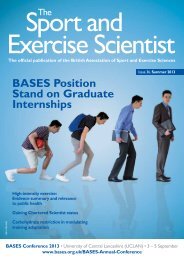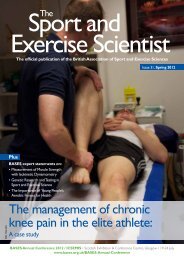Issue 33 Autumn 2012 - Bases
Issue 33 Autumn 2012 - Bases
Issue 33 Autumn 2012 - Bases
- No tags were found...
You also want an ePaper? Increase the reach of your titles
YUMPU automatically turns print PDFs into web optimized ePapers that Google loves.
The coach-athlete relationshipIt is widely accepted that significant personal relationships can influence the development and performanceof athletes. None, however as fundamental for performance as the relationship the athlete has with his/hercoach. Here, Dr Sophia Jowett speaks to Claire-Marie Roberts about operationalising this relationship.How significant are coach-athlete interactionsin the context of athletic performance success?The coach-athlete relationship defines coachingpractice: coaches instruct on one hand and athletesexecute instructions on the other. Thus, successfulcoaching or performance success more specifically isthe combined interrelation between the coach and theathlete. It is certainly evident in the relevant literaturethat neither the coach nor the athlete can “do it alone”– they need one another to reach athletic performancesuccess be it to win Olympic/Paralympic medals, tosimply develop a skill, enjoy the sport, or maintainmotivation. The quality of this relationship mattersbecause it can make the journey to skill developmentand performance success much more satisfying, fulfilling,motivating, energising, you name it!How are these interdependencies between theathlete and the coach represented?We defined the coach-athlete relationship asthe social situation in which a coach and an athlete’sinterpersonal feelings, thoughts and behaviours aremutually and causally interdependent. This definitionprovided the basis for building an operational modelthat was capable to help us study the coach-athleterelationship systematically and in an organised fashion.At this present time, the interpersonal constructs ofCloseness, Commitment and Complementarity form anintegrated model of the coach-athlete relationship (the3Cs model) and define the quality of the coach-athleterelationship. Co-orientation is the fourth C of themodel and essentially highlights the degree to whichthe dyadic members are similar and in agreementrelative to how they view their relationship. The 3+1Csmodel (and the accompanying psychometric tools:Coach-Athlete Relationships Questionnaires) providea means to studying the content and functions of thecoach-athlete relationship.From a practical perspective, what variables areknown to influence this relationship?Our research suggests that there are a numberof factors. For example, personality characteristicsappear to influence how coaches and athletesperceive their relationship. For example, athletes withpositive personality characteristics (e.g., openness,consciousness) are more likely to view the relationshipquality more positively. Additionally, it would appearthat same gender coach-athlete dyads have betterrelationship quality leading to athletes and coachesthat are more satisfied with training, instruction, andperformance than other gender coach-athlete dyads. Interms of sport, athletes in team sports would appearto be less satisfied with the relationship quality thanwords: Dr Sophia JowettSophia is a Reader inPsychology at LoughboroughUniversity. The coach-athleterelationship has been herresearch focus for over 15years.Interview by:Claire-Marie Roberts,University of GlamorganFurther reading:Byrne, D. (1961).Interpersonal attraction andattitude similarity.Journal of Abnormal SocialPsychology, 62, 713-715.Jowett, S. (2007).Interdependence analysisand the 3 + 1Cs in thecoach-athlete relationship. InS. Jowett & D. Lavallee (Eds.),Social psychology in sport(pp. 15-27). Champaign, IL:Human Kinetics.Jowett, S. (2009).Validating coach-athleterelationship measures withthe nomological network.Measurement in PhysicalEducation and ExerciseScience, 13, 1-18.athletes in individual sports. These findings have cleartheoretical and practical applications and pave the wayfor more and better research in this area.In terms of increasing the chances ofperformance success are you saying thatresearch suggests the coach should be the samegender as the athlete?No. It would appear from the research thatsame gender coach-athlete dyads may be moreinterdependent (perceiving high levels of 3Cs) andmore satisfied with sport, relationship, and trainingfor example. This can be explained employing thesimilarity-attraction hypothesis (Byrne et al., 1986).Accordingly, these coach-athlete dyads may beattracted to one another and feel happy because theyhave something in common (i.e., their gender). Thus thefact that these dyads are of the same gender may givethem a perceived advantage over other gender dyads(actual similarity leads to attraction). However, we haveargued that communication is the key to developingand maintaining relationships that are effective andsuccessful. Coaches (and athletes) can thus usecommunication to foster perceptions of similarity suchas “we have things in common” such as our love forsport and similar goals (perceived similarity leads toattraction). Research in this area can certainly furtherpromote our understanding about how different typesof similarity (actual vs. perceived) influence the qualityand functions of the coach-athlete relationship.You mentioned the differences in levels ofcoaching satisfaction amongst individual andteam athletes. What are the reasons for this?We have speculated that one of the reasons for thismay simply reside in coaching practices. Traditionally,coaches in individual sports although they will operatein a squad of athletes, each athlete will get, in one wayor another, individual attention to improve his/hertechnique, tactics, attention/focus or some other aspectof performance. Thus, athletes in individual sports willget more individual instruction. Conversely, coachesin team sports provide most of their instruction at ateam level. This may cause the effects we noted (i.e.,individual sport athletes are more interdependentto their coaches: perceive higher levels of 3Cs andthey are also more satisfied with performance andinstruction than their team sport counterparts). Thepractical significance of this finding is that it may beuseful for coaches in team sports to try to createsituations where more one-to-one training/instructiontakes place, thereby improving coach-athleterelationships, increasing satisfaction, and in the longerterm, improvements in performance.16 The Sport and Exercise Scientist n <strong>Issue</strong> <strong>33</strong> n <strong>Autumn</strong> <strong>2012</strong> n www.bases.org.uk


